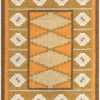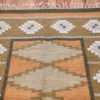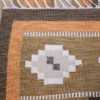Vintage Swedish Kilim Rug by Ingegerd Silow 48511
A Geometric Design Vintage Mid Century Modern Kilim Rug by Ingegerd Silow, Origin: Sweden, Circa: Mid 20th Century — Ingegerd Silow is one of the most influential textile designers of mid 20th century Scandinavian rugs. This cheerful vintage mid century rug reflects the typical elements of both her work, and the artistic movement of which she was a part.
These rugs are part of a stylistic Scandinavian and Bauhaus design movement that began in the early part of the 20th century. These breathtaking vintage rugs reached their height of popularity during the mid-20th century postmodern era and have remained an iconic design staple with their clean geometric designs since that time. They have recently found their way into organic, Scandinavian, minimalist and other interior design styles that rely on a sense of order, line and form.
This happy rug utilized a just a handful of colors such as orange, green, cream and brown to create the overall artistic impact. The colors of this beautiful Swedish kilim rug contribute to an overall feeling of sunniness and summer sunshine to any room’s interior decor.
This Ingegerd Silow rug demonstrates the geometric elements of the Scandinavian rug weaving movement. The motifs are perfectly symmetrical both vertically and horizontally, adding a sense of order and form. The flow of the design elements draw the eye both horizontally and vertically along the flat woven area rug.
The use of bold graphic geometric design elements in the motif reflects the artist’s love of nature and the natural world around her. Silow was dedicated to sustainability and much of this love was reflected in her rug styles and designs.
The bold character of this vintage Ingegerd Silow kilim carpet will not allow it to be tucked away unobtrusively in a corner. It was meant to be admired, seen and used as a central focal point of the interior design.
The artist, Ingegerd Silow, signed the rug, which further adds, and is indicative of, the textile art approach that Silow had when she designed her carpets.
Elegantly understated in its large stitching and simple use of color, this Swedish area rug is defined by its minimalist charm. Two small borders of coffee brown and mandarin orange are snugly set against a larger border of cinnamon. Within this larger frame are several rounded shapes embroidered in a muted taupe hue. Each row of these shapes is broken up by white stitching that runs horizontally within the border, with the space at the very center of the kilim rug featuring attractively stacked, wide diamond shapes, all set against a bright orange background. It is a wonderful example by and iconic textile artist.


















